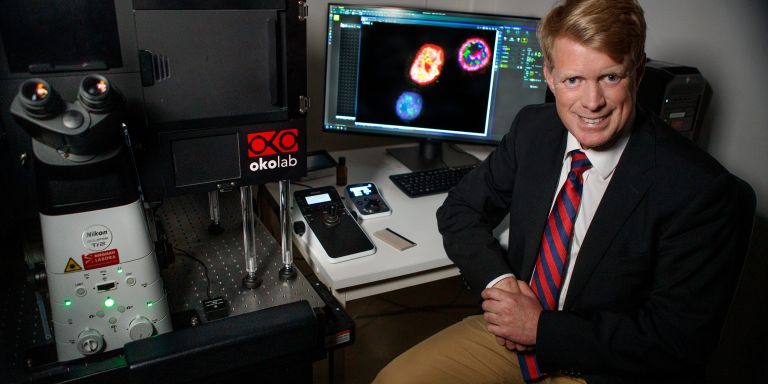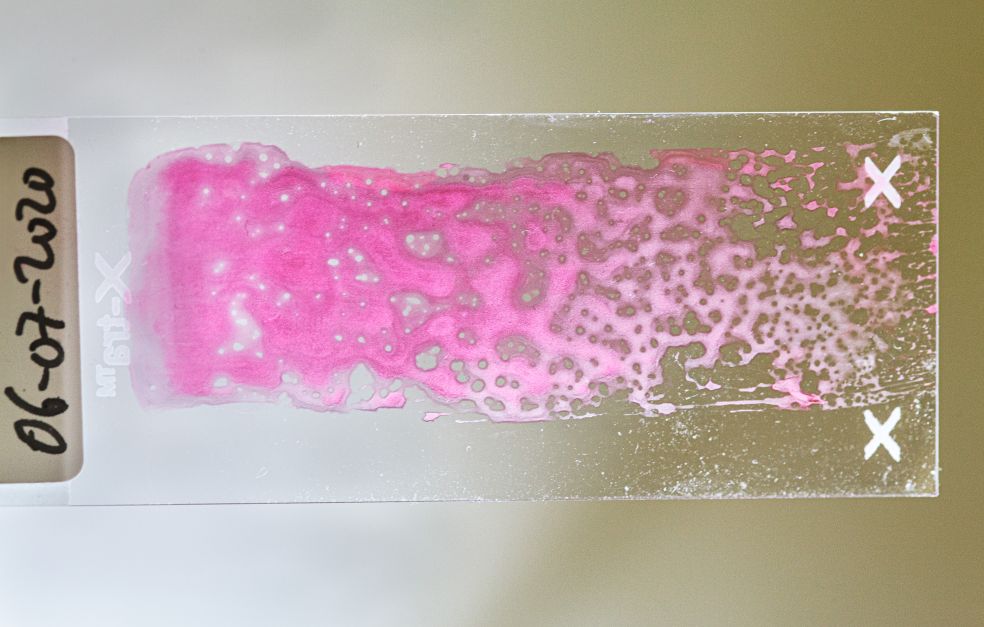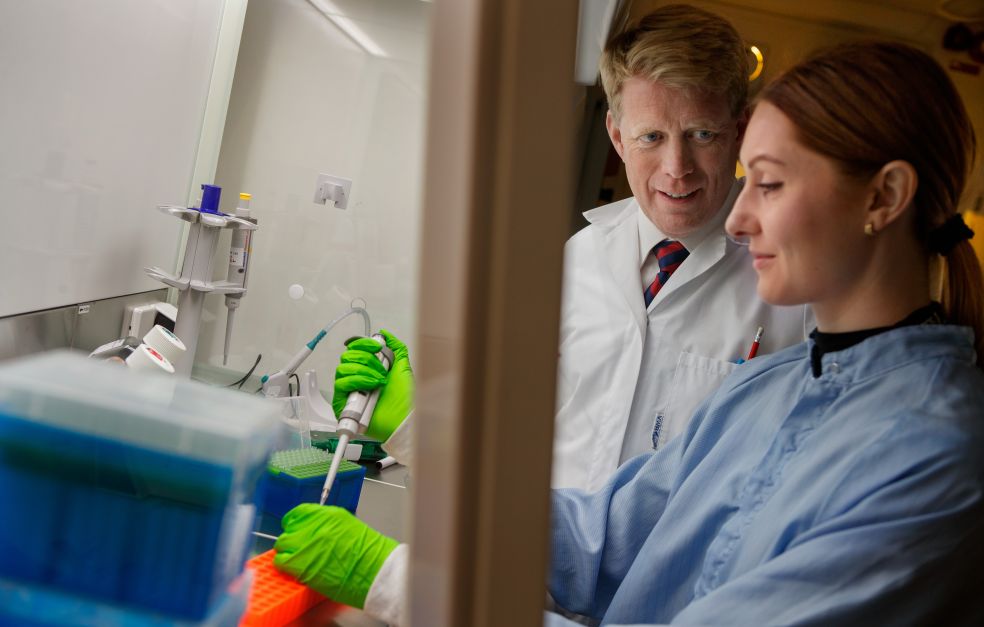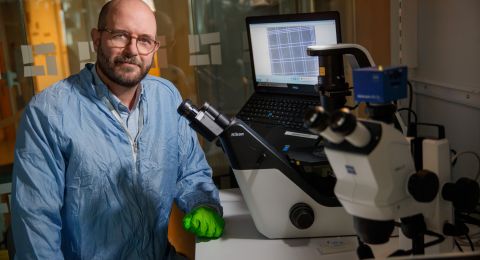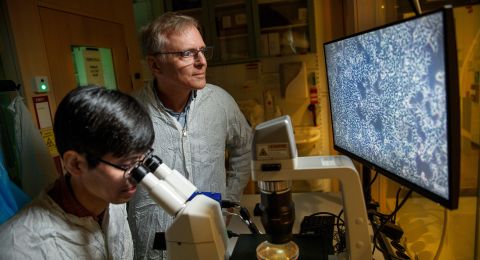Is it possible to repair oxidative damage in cell DNA by introducing small molecules that can activate a repair protein? If so, a medical paradigm shift may be on the way, according to Wallenberg Scholar Thomas Helleday.
Thomas Helleday
Professor of Chemical Biology
Wallenberg Scholar
Institution:
Karolinska Institutet
Research field:
Examining whether new molecules can repair DNA damage caused by oxidative stress
When we eat, drink and breathe, nutrients are broken down in our body, we become warm and receive energy. But reactive oxygen compounds are also formed, causing oxidative stress and potentially damaging parts of our cell DNA.
This can be a factor in the onset of diseases such as Alzheimer’s, cancer, autoimmune diseases and cardiovascular disease.
Professor Helleday and his research team at Karolinska Institutet and SciLifeLab intend to develop a new method for treating diseases of this kind.
Oxidative damage also impacts how we age – and the team wants to study whether ageing can be treated with the method.
They will now explore small synthesized organic molecules, which they refer to as “amplizymes,” combining the words amplify – strengthen, and enzyme – a catalyst of biochemical processes.
Their aim is to find out and verify whether amplizymes can act as catalysts and activate a new biochemical process to improve the repair of DNA damage in the body’s cells.
Chance happening
Helleday recalls how the team discovered the small molecules by chance when they were pursuing another line of inquiry.
“We found molecules that behaved slightly differently and that might be able to repair DNA more quickly and serve as some form of activator in the protein that binds to and repairs DNA damage,” he says.
That discovery was more important than the researchers realized. It transpired that the molecules also catalyze a new biochemical process in the protein.
The new findings were published in the U.S. journal Science in 2022.
The body’s own cells contain a naturally occurring protein called OGG1, which binds to oxidized DNA bases to cut them out from the DNA.
OGG1 identifies and cuts out an oxidized base in a strand of DNA, and is then helped by another protein to cut the DNA strand itself so it can insert a healthy DNA base. The process is slow and does not always have time to effectively repair all DNA damage.
Adding an amplizyme
In the first part of the project the researchers will add the first amplizyme they have selected for study – TH10785 – and ascertain how it creates a new catalytic function in the OGG1 repair protein.
Experiments have shown that it can repair oxidative damage ten times more effectively – and also cut the DNA via the new function, something OGG1 is normally unable to do on its own.
“We first want to understand the mechanisms in depth, and then we will also examine and verify the biological effects of using OGG1 amplizymes to repair DNA damage,” says Helleday.
The second part of the project will be to examine whether amplizymes can be used to make drugs of the future for diseases for which there are currently no therapies, such as liver disease and neurodegenerative diseases – and whether those drugs can also slow or reduce ageing.
I don’t think that if you want to live for 200 years, it will suffice to use drugs merely to inhibit proteins. A good approach might be to increase the activity of repair proteins instead and see whether that works better
The fundamental premise in drug development has long been to find specific proteins that cause diseases and treat them with drugs that inhibit enzyme activity.
Yet many diseases arise because proteins in the body’s cells lose their abilities and functions. Helleday’s research team intends to reverse this process by stimulating enzymes to activate repair of oxidative damage to DNA.
“I don’t think that if you want to live for 200 years, it will suffice to use drugs merely to inhibit proteins. A good approach might be to increase the activity of repair proteins instead and see whether that works better,” he says.
Microscopic quantifies
The researchers at SciLifeLab have also found that microscopic quantities of the amplizyme substance seem to suffice to achieve the desired response, which is an advantage.
Helleday is a biologist, and became a professor at the age of 34. He was previously based at Stockholm University and then Sheffield in the U.K., followed by University of Oxford, where he was involved in establishing a cancer research institute.
DNA damage due to oxidative stress also occurs in cancer cells. In 2003 Helleday discovered that hereditary breast and ovarian cancer cells need a protein called PARP in order to survive. He then developed a PARP inhibitor treatment that was approved for medical use in the EU in 2014.
The drug prevents cancer cells that are mutated in the BRCA1 or BRCA2 genes from repairing their DNA damage, upon which the cancer cells die. This research has saved the lives of tens of thousands of people across the world suffering from hereditary forms of cancer of the breasts, ovaries, pancreas or prostate.
The first person to identify DNA damage and lay the foundations for the “DNA repair” approach that the Helleday team are now pursuing, was the Swedish biochemist Thomas Lindahl, who received the Nobel Prize in Chemistry in 2015 for his discovery.
“We hope that our approach, focusing on catalytic medicine, will ultimately enable us to eliminate oxidative damage and improve human health. But much work remains to be done,” says Helleday, adding:
“We must prove that the method is effective, and it’s going to take an awful lot of work to do so.”
Text Monica Kleja
Translation Maxwell Arding
Photo Magnus Bergström

